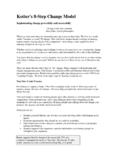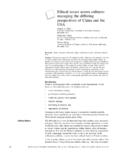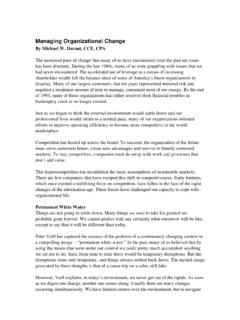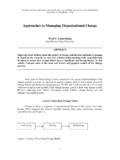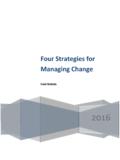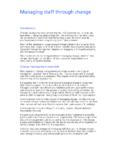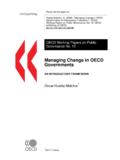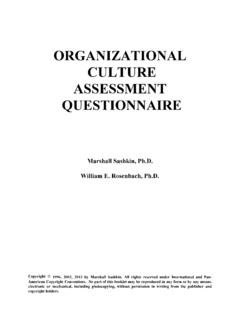Transcription of The Government Office for the South West Envirowise Over ...
1 Resource Efficiency andCorporate ResponsibilityResource Efficiency and Corporate Responsibility Over 40,000 copies issued worldwide excellent and enjoyable ground breaking very useful How to manage changein an organisationPractical Environmental Advice for BusinessPPractical Environmental Advice for BusinessPHere is just some of the reaction to this unique and highly popular guide: Cheers to the Brits for their humour National Healthcare Manager for Energy Star, Environmental Protection Agency, USA We are using the guide's change Management Matrix as a simpleand effective tool to diagnose how we are responding to climatechange at all levels of our organisation. It serves as a route map forour Climate change Project Group to drive progress at allmanagement levels. We use it to support regular reviews whichensure we maintain momentum. Regional Director, Environment Agency ( South West), Exeter do think that this would be of great interest to manyof our business and corporate clients MDfor UK based life coach training company Use of the guide's change Management Matrix as a diagnostic tooland route map has enabled us to identify and prioritise our nextmoves to make more rapid We shall continue to use thematrix to re-examine and maintain our performance levels Riviera International Conference Centre, Torquay we intend to use as a resource in MBA teaching Warwick Business School, University of WarwickThe Government Office for the South West( ) seeks to ensure thatSouth West England develops in line with theprinciples of sustainable development.
2 Itprovides the management and ongoingdevelopment of the , the region s focus on sustainabilityissues where this guide and other similarmanagement guides, including our GreenerEvents guide, can also be a valuableprogramme of free, confidentialadvice to UK businesses of all sizes -helping them become more resourceefficient to reduce theirenvironmental impact and savemoney. For independent, practicalguidance call 0800 585 794 or Resource Efficiency andCorporate ResponsibilityDesign by Ampersand Design Ltd. Tel: 01235 861444 January 2007 edition Crown copyright. First printed January 2004. Reprinted April 2004 and November on paper containing a minimum of 75% post-consumer waste. This material may be freelyreproduced in its original form except for sale or advertising purposes. it is not the strongest species that survive, nor themost intelligent, but the ones who are most responsiveto change Charles Darwin To cope with a changing world, an entity mustdevelop the capacity of shifting and changing ofdeveloping new skills and attitudes.
3 In short, thecapability of learning A De Gues, The Living CompanyManaging change is a very important factor in the success of every guide will help managers think creatively about how they managechange, whilst avoiding many of the pitfalls that other companies guide is published on where the ChangeManagement Matrix can also be down-loaded as a single page documentfor management team discussions on how the organisation is identifying the weaker areas that require Environmental Advice for BusinessPractical Environmental Advice for BusinessProduced byEndorsed byCarbon TrustEnergy Services and Technology AssociationSouth West of England Regional Development AgencySouth West Climate change Impacts Partnership managingchange1 CONTENTS:PART ONE: .. 2 managing change A guide on how to manage change in an organisation Introduction .. 2 Worst Practice in managing change .
4 3 The Four Factors for Success:.. 51. Pressure for change ..52. A Clear, Shared Vision .. 73. Capacity for change ..134. Action ..14 change Management Matrix .. 16 PART TWO: .. 18 Energy & Environmental Management Worst Practice GuidePART THREE: .. 32 Energy & Environmental ManagementInfluencing Senior Management Getting It Wrong Part One of this guide has been written by Phil Harding, Head of SustainableBusiness, Government Office for the South West, 2004. Parts Two and Threewere written for the Government Office for the South West by John Pooley ofThe John Pooley Consultancy. Envirowise & Government Office for the South West, 2004 PART ONE: managing ChangeA guide on how to manage changein an organisationIntroductionThis guide has been written for the purpose of helpingorganisations manage change as they seek to becomemore sustainable through resource efficiency and takingcorporate responsibility for the effects of the business onthe wider community.
5 It can also be used as a tool byenvironmental business support organisations whenassisting companies. Much of the advice in this guide is little more than the applicationof common sense and good management practice, but all toooften some of these elements are overlooked. By taking asystematic approach to implementing change , managers can bemore successful in taking colleagues with them and achieving four key factors for successwhen implementing changewithin an organisation are:zPressure for change demonstrated senior managementcommitment is essentialzA clear, shared vision you must take everyone with is a shared agenda that benefits the whole organisationzCapacity for change you need to provide the resources:time and financezAction and performance plan, do, check, act andkeepcommunication channels openmanaging changePART ONE: managing ChangeA guide on how to manage change in an organisation2 This guide includes tips and techniques that can be deployed tobetter manage change internally.
6 The change ManagementMatrix on page 16 of this guide is a simple tool for identifyingand plotting status and progress in an organisation. This shouldhelp you structure your process of managing change to get youfrom the raising of Awarenessand Interestto DesireandAction (A > I > D > A).Worst Practice in managing ChangeBefore looking at the four factors for success, recognising thefour factors for failurein managing change can help identifyproblems more rapidly, and can show where initial action shouldbe concentrated:zLack of consistent leadershipzDemotivated staff kept in the darkzLack of capacity: budget cuts, no spend-to-save policy,short-termapproach to investment, stressed out staffworking hard just to stand still zLack of initiative to do something different .These four factors for failure then lead to the tread-mill effect ,setting up a vicious circle 1. No time for reflection, planning and learning2.
7 No improvement in design and implementation 3. Increasing need to do something4. Increasing failure and unplanned consequences3changePART ONE: managing ChangeA guide on how to manage change in an organisationThe main dangers in this life are the peoplewho want to change everything or nothingLady Nancy Astor Implementing the four factors for success can help get you offthe tread-mill described on page changePART ONE: managing ChangeA guide on how to manage change in an organisation4 The following employee excuses demonstrate thatchange is being managed badly and that employees areincreasingly demotivated: it s not my job I haven t got time the boss doesn t careanyway I m keeping my head downthis time if it s such a good idea, why didn t we do this the last timemanagement changed its mind? it will all change again next month when the MD makes his mind up,I might do something nobody told me about The Four Factors for Success:pressure shared vision capacity actionFactor 1: Pressure for change (the top down approach)Firstly there must, of course, be pressure for change a drivingforce.
8 The need for change has been identified, the decision toproceed has been taken, and this now needs to becommunicated throughout the organisation. Pressure for change could be senior management commitmentfrom the outset, but it may have come from customers or clientsin a supply chain. It could come from a regulatory regime, suchas Integrated Pollution Prevention and Control (IPPC), theimplementation of an Environmental Management System or,and this can often be the most effective source, pressure fromthe workforce themselves. Who wants to work for a company or an organisation that hasdeveloped a notorious reputation for polluting the environmentor exploiting its suppliers? It is widely accepted that whenpeople take a pride in the organisation they work for, theyperform better and will more readily put themselves out to helpachieve corporate success, however, regardless of where the original pressurefor change came from, senior management commitment anddrive for change is essential if momentum is to be maintainedfor effective implementation.
9 5changePART ONE: managing ChangeA guide on how to manage change in an organisationLeadership is getting others to do what youwant them to do because they want to do itEisenhower The rest of the organisation will need to be convinced of the needand the case for change this is dealt with in more detail in Factor2: A Clear Shared Vision. Only this can happen to good effect ifsenior management, including the Chairman and Chief Executive,are collectively behind the changes sought. Senior management must be seen to be fully supportive by whatthey do and say both privately and publicly. If, however, seniormanagement talks-the-talk by failing to back up their statementswith action and a continuous commitment, progress can soonstall. Other conflicting or new priorities emerge and themomentum can be lost if senior management fail to remain fullysupportive of the , get senior management signed up to the change .
10 Andcommunicate this to all staff giving them the opportunity tofeed in their contributions and feel that they have jointownership of the change being companies are already signed up to becomingmore sustainable through resource efficiency, using cleanertechnologies, minimising waste and embracing the principles ofproducer responsibility. But being more sustainable in itsbroadest sense also means attending to social responsibilities asa good employer by, for example, encouraging fairness at work;helping staff to develop their skills; introducing green transportplans; being a good neighbour that is responsive to the localcommunity; and as an ethical is the positivemessagethat needs to be communicated throughout changePART ONE: managing ChangeA guide on how to manage change in an organisation6 Our character is what we dowhen we think no one is looking H Jackson Brown (Jnr) An environmental policy (whether new or improved) can be thesignal to staff that things are changing, and that they have a roleto play in making this happen.
